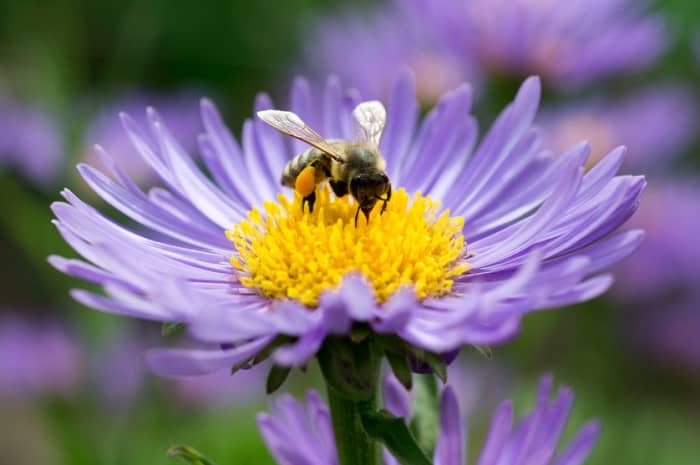Is Garden Safe Fungicide 3 Safe For Bees
Susan loves creating a bee-friendly environment in her garden.

Creating a bee-friendly environment in your garden can help reduce colony collapse.
Why Is a Bee-Friendly Garden Important?
In many parts of the world, bees and other pollinators like butterflies are in decline. The reasons are varied and complex.
One reason is modern agricultural techniques. The development of cities and towns causing the loss of farmland and natural habitats such as wild flowers and meadows are another one of the reasons. Colony collapse and the loss of honey bee hives, however, threaten our food supply.
What Is a Bee-Friendly Garden?
A bee-friendly garden is one where you plant the honey bees' favorite flowers. Flowers that attract them to your garden and are rich in pollen and nectar.
Most flowers pollinated by bees are either yellow, white, or blue. They often have ultraviolet markings, so they are the colors bees like best—or at least the colors bees are most attracted to.
Which Flowers Are Bee Friendly?
- Bee-friendly flowers are rich in pollen and nectar.
- Choose single flowers over double flowers, and plant ones that bloom throughout the spring and summer.
- Also plant early-blooming flowers, such as hawthorn, apple blossoms, and crocus just to name a few.

Early-blooming crocus.
Four Essential Elements for Designing a Bee-Friendly Garden
- Choose plants that are best suited for attracting bees in your region.
- Limit the use of insecticides that are toxic to bees and other beneficial pollinators.
- Provide shelter in your garden from elements such as wind, rain, or cold.
- Create a habitat for the nest of the pollinator to support the entire life cycle of the pollinator, from egg to larvae to adult.
What the Honey Bees Need, See, and Smell
- Each honey bee has 170 odorant receptors. They use this to recognize different types of flowers when looking for food.
- When picking your plants for your bee-friendly garden, remember that they cannot see red. Red looks like black to the honey bee.
- Ultraviolet patterns guide the honey bee. So they can see colors a human cannot see and can only imagine.
- Honey bees need water.

Read More From Dengarden
Colors and Flowers That Attract Bees
- Violet flowers where the bees swell produce far more nectar than any other color.
- Blue is the next most-rewarding color, followed by yellow.
- Bees prefer single-headed flowers.
- They also prefer brightly colored (or lighter pale) plants.
How to Help Sustain Your Honey Bee Guests
- Bees love native wild flowers.
- They are also attracted to flowering herbs.
- Provide a fresh water source for your bees.
- Appreciate the beauty of weeds for the honey bee. Dandelions, clover, and goldenrod are flowering weeds that nevertheless delight honey bees.

Bees love sunflowers.
Help Your Honey Bees in the Winter
- In the winter, allow your grass to grow longer and the hollow stems of perennials to remain uncut to offer additional shelter.
- Cutting your lawn less frequently enables low-growing flowers such as clover and daisy to flower longer, which allows more food for the wonderful honey bee.
Some Additional Tips for Bee-Friendly Gardens
- Early-season flowers offer welcome sustenance to overwintering bees that are lured out on days above 50°F in late winter and early spring. Providing blooms for them can be of great help. Some of those flowers include Black-Eyed Susans and late-summer goldenrod.
- Summer bloomers for the honey bee include clover, calendula, borage and sunflowers—the latter of which also contain hundreds of tiny individual flowers that keep a bee busy for hours.
- End-of-the-year flowers include asters, echinacea, and common ivy.
- Also remember to include flowers within your vegetable plot.
Kinak-pops from Oahu, Hawai'i on July 04, 2019:
Thanks, I knew there was one color bees can't see but couldn't remember. Looks like I'll be getting some yellow flowers today.
Susan (author) from Dover Delaware on July 04, 2019:
How come overtime you comment on my article my picture of my article gets smaller, and the description disappears. I would rather the picture and description stayed rather then the comment.
Susan (author) from Dover Delaware on July 04, 2019:
Wow you seem to have the same type of articles as I write, or at least some of them. However, I think mine might have a different type of twist on them. Stayed tuned you might see one that you find different from yours. Didn't forget the bumble bee. They do pollinate but usually make a teaspoon of honey. Maybe I will do a page on them, but have others I want to do first. Good luck with your garden. Like to post a picture of mine this year, I have tomato plants four foot tall hanging full of tomatoes. I love this time of year, and I love my garden. If you read all my articles you will see why I plant some of my plant life now. In memory of my beautiful son, who was brutally murdered in 2015. Read Ghost of Meadow Brook Acres Set Free. In his memory God has blessed the plant life on this 1/4 acre of ground. It is as beautiful as he is.
Is Garden Safe Fungicide 3 Safe For Bees
Source: https://dengarden.com/gardening/Planting-Your-Bee-Friendly-Garden
Posted by: olveratwerse1989.blogspot.com

0 Response to "Is Garden Safe Fungicide 3 Safe For Bees"
Post a Comment